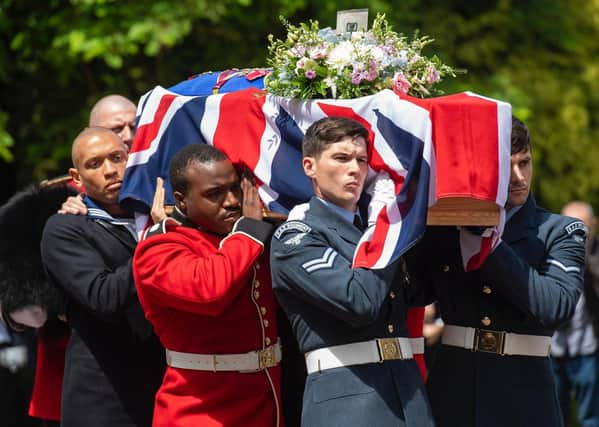Flypast at funeral for WWII singer Dame Vera Lynn


Two Second World War fighter planes soared over Ditchling to remember the late singer.
The aircraft made three passes over the quiet village before leaving to applause from the crowd.
Advertisement
Hide AdAdvertisement
Hide AdThe adored singer, who entertained troops with morale-boosting visits to the front line during the Second World War, died aged 103 on June 18.
The cortege bearing Dame Vera’s coffin, which was draped in a Union flag, arrived in the village centre as a bell tolled out.
Hundreds of people were gathered at the crossroads ahead of the procession, which was led by soldiers.
Representatives from the Royal British Legion stood in the road with flags as they waited to honour Dame Vera.
Advertisement
Hide AdAdvertisement
Hide AdA small police presence was also on hand to ensure proceedings went smoothly.
The cortege paused for several minutes in the centre of the village where Dame Vera loved happily for 60 years, awaiting the flypast.
There was applause from the crowds as the two Second World War fighter planes flew over the little village in honour of the national treasure.
Sounds of the roaring engines filled the streets as the aircraft banked around the Sussex countryside.
Advertisement
Hide AdAdvertisement
Hide AdThe cortege then made its way out of the village as it continued its route to the crematorium in Brighton, bid farewell by shouts of “hip hip hooray” from the crowd in her honour.
It was followed by a spontaneous rendition of We’ll Meet Again, one of the songs Dame Vera was well-known for.
The cortege was greeted in Brighton by service personnel in uniform outside the chapel, including a military bearer party who were ready to receive the coffin.
A bugler from the Royal Marines was drafted in to provide a musical tribute inside the chapel, and the Ministry of Defence was to be represented by a senior officer. The funeral service was not open to the public, with attendance limited to a small family group as well as the officer and bugler.